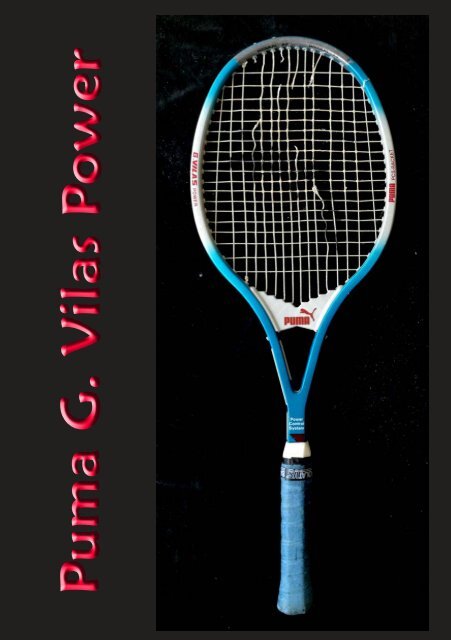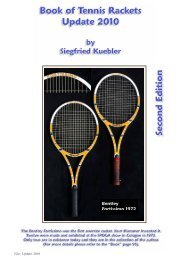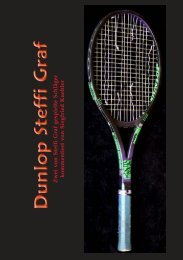VilasEng
Racket G. Vilas Power
Racket G. Vilas Power
- No tags were found...
Create successful ePaper yourself
Turn your PDF publications into a flip-book with our unique Google optimized e-Paper software.
1
© Copyright 2020<br />
by<br />
Siegfried Kuebler<br />
Zur Grundel 18<br />
D 88662 Überlingen
Comments on Puma G. Vilas Power Racket<br />
It was another day that I should take a walk since the<br />
weather is nice and I need exercise at my age. This is what<br />
my friend Rolf recommends me, but also my wife Regine.<br />
I came back out of breath. There are 54 steps up to my<br />
office in our house, including the stairs in the garden. They<br />
were still ahead of me. I came to the lower entrance and<br />
opened the door. Closing it produced a rich sound. Yes,<br />
this is a security door, installed two years ago. The burglars<br />
would bite their teeth if they tried it. However, around<br />
the house were easier ways.<br />
About 20 vintage tennis rackets are exhibited on the wall<br />
to the left. With appropriate explanations. They are very<br />
special because they are rackets from former world-class<br />
players, some of which even have their signature, either<br />
on the frame or on the wrapping leather of the handle.<br />
Well-known names are included. Michael Stich, Steffi Graf,<br />
Boris Becker, Claudia Kohde Kilsch, Harold Salomon, Björn<br />
Borg. However, who still remembers Steeb? Wasn’t his<br />
first name Charlie? Do you remember Evonne Goolagong?<br />
One of the rackets had come off the wall and was lying<br />
on the floor. I picked it up and wanted to put it back again.<br />
Then I saw its inscription. Puma PCS racket, G. Vilas Power.<br />
Memories came up. Günter Adam had developed that<br />
racket. I still remembered, I think it was in autumn 1983,<br />
when he stood in front of my little factory in Singen. Here<br />
we made the Kuebler rackets. I knew him from the Ispo<br />
sporting goods fair in Munich. He was the leading development<br />
engineer at the Völkl Company, which made tennis<br />
rackets and skis very successfully. What did he want from<br />
me?
He quickly came out with the language. He invented a<br />
racket, the length of which to be easily changed by turning<br />
a screw at the end of the handle. This allows any player to<br />
change the rackets playing characteristics. Longer means<br />
more power, less feeling.<br />
Of course, this thought was not new. How many inventors<br />
have let off steam? I have to admit that we also built<br />
such test rackets. We failed because the adjustment worked,<br />
but without tightening additional screws on the handle,<br />
crackling noises repeatedly occurred when the racket<br />
met the ball, which of course no player would tolerate.<br />
„Would you make and distribute this racket for me according<br />
to my preregistered patent? „<br />
His offer came as a surprise. Why did not Völkl want to<br />
build this racket itself? My opinion was at that time: the<br />
Patent Office would possibly not grant his application owing<br />
to lack of inventiveness.<br />
I explained to him our own test results and politely declined.<br />
In retrospect, this decision was the right one, as it<br />
would show later. He continued to pull his strings and<br />
ended up at the Puma Company, which had not yet been<br />
active in the tennis business, although its fierce competitor<br />
Adidas already made and sold rackets.<br />
Puma got on with enthusiasm. In-house production was<br />
set up. The racket became a hit because G. Vilas was fond<br />
of it and could be won as the top player of the world. Lefthanded,<br />
born in 1952, then just over 30 years old. At the<br />
age of 21, he had already played his first Grand Prix tournament<br />
in Buenos Aires. In his career, he should win 62<br />
titles. These included the French-, the US- and the Australia<br />
Open. Until 1977, Vilas remained undefeated in 46 games<br />
in a row. The undisputed No. 1. The winning streak ended
in the final of the Aix-en-Provence tournament, when Vilas<br />
gave up against Ilie Nastase (then outsider against Vilas).<br />
Nastase competed in the final with the so-called spaghetti<br />
stringing on an Adidas Nastase Professional Racket,<br />
banned by the International Tennis Federation immediately<br />
after this tournament at the behest of Ion Tiriac. After<br />
two lost sets, Vilas gave up, exasperated by the uncontrolled<br />
bouncing of the ball. Nastase thus secured the trophy.<br />
Vilas, angry after the game, snorted; „I didn’t lose against<br />
Nastase, but against a racket with this crazy spaghetti stringing!<br />
„<br />
With this innovative double stringing, as it was later also<br />
called, the ball got an incredible spin. When jumping off<br />
the ground, the ball’s trajectory had mostly become unpredictable.<br />
Vilas could not cope with that.<br />
However, back to Puma. The G. Vilas Power Racket was<br />
born. As a young man, Boris followed his idol Vilas and<br />
used this racket.<br />
He remained loyal to it until the end of his career. The<br />
Puma Boris Becker Winner joined the G. Vilas Power. Do you<br />
remember? Red in the upper part, lower part up to the<br />
handle dark blue?<br />
Nevertheless, Puma’s initial enthusiasm should not last<br />
long. Of the 200,000 rackets, that were allegedly manufactured<br />
and sold, half are said to have come back as a complaint,<br />
because of noises in the handle when hitting a ball. I<br />
was afraid of this from the start and was happy about my<br />
rejection at the time. This would have ruined my Company.<br />
Puma was unable to solve the problem satisfactorily.<br />
After a few years, Puma stopped manufacturing and sel-
ling rackets. A short, loss-making trip to the tennis racket<br />
business, which is characterized by fierce competition.<br />
In addition, the G. Vilas racket and the Boris racket that<br />
the two used. Did not they make any noise when hitting<br />
the ball? A liquid two-component resin was injected into<br />
the interstices of the handle scales, so that the adjustability<br />
of the length was cancelled. The PCS (Power Control System),<br />
heavily propagated, had died.<br />
Vilas had strongly influenced the tennis world through<br />
his game, his personality and his appearance in colorful<br />
sports clothing (at that time white was more popular). Long<br />
hair under a headband, figure-hugging clothes and topspin<br />
strokes. Does that sound like Bjorn Borg? Right. Also<br />
a poet who attracted attention in Argentina with a book of<br />
poems and became the pioneer of the wonder weapon<br />
Topspin, which at the time only Borg could take on.<br />
Vilas won the Romanian Ion Tiriac as his manager. Vilas<br />
became a champion. As for his rackets, he was not as consistent<br />
as other world-class players like Boris, Edberg or<br />
Sampras, just to name a few. So at the beginning of his<br />
career he played with the Wilson Jack Kramer Autograph,<br />
followed by the HEAD Vilas (similar or even identical to<br />
the HEAD Royal in Europe and HEAD XRC in the USA),<br />
then the Slazenger Vilas International and Slazenger V-24,<br />
and finally the Puma G. Vilas. The decisive factor for the<br />
switch from Slazenger to Puma was a tournament in Las<br />
Vegas 1984/85), which he won with the Puma G. Vilas Power<br />
Racket.<br />
I am still holding the G. Vilas Power in my hand that had<br />
dropped. Vilas had scribbled his name on the side and is<br />
said to have played this racket at the World Team Cup in<br />
Düsseldorf in 1987.<br />
6
How did I get this racket? At that time Siegfried Schwank<br />
was a well-known stringer and attended many international<br />
tournaments with his service. He was Steffi Graf‘s favourite<br />
stringer for her the rackets and for many other<br />
well-known tennis players. At that time he was also involved<br />
in this tournament in Düsseldorf and stringed the rackets<br />
for Vilas. Vilas gave him this racket, which had broken<br />
on the frame as well as the strings.<br />
I noticed some special features that I would like to discuss<br />
here, when looking at this G. Vilas Power racket. Its weight<br />
is remarkable. Self-adhesive lead tapes are attached to the<br />
head. Together with the stringing 385 grams. At that time,<br />
the preferred weight was 360 grams. The length of a racket<br />
was more or less unchanged at 68 cm for 100 years.<br />
The G. Vilas Power has 69 cm. Unusual for the time.<br />
Before the handle scales could no longer be moved by the<br />
introduction of an adhesive, the screw at the end of the<br />
handle, as can be seen in the picture, could no longer be<br />
turned and the PCS system was thus dispensed with, the<br />
racket reached its maximum length of 69 cm.<br />
Small Elasto Cross<br />
plastic parts are<br />
clamped at the<br />
crossing points<br />
7
Stretchy grommet<br />
strip, accordion-shaped<br />
The broken relatively thin gut strings (Babolat?) are probably<br />
16L gauge with a diameter of 1.28 mm. With the<br />
topspin style of Vilas, it can be assumed that he had a lot of<br />
string wear.<br />
He inserted the small pieces of plastic that appeared at<br />
the centre of the playing surface at the crossing points:<br />
Elasto Cross, in order to minimise the wear on the strings.<br />
Top players today such as Roger Federer occasionally still<br />
use them. Wilson and Babolat offer Elasto Cross sets.<br />
Incidentally, Günter Adams invented the accordionshaped<br />
grommet strip. This strip fits always even if the<br />
holes for the eyelets in the frame are not precisely drilled.<br />
Two cracks in the frame on the top right and bottom of<br />
the frame on the left indicate, based on my experience with<br />
hundreds of returns of tennis rackets we have made, imply<br />
that Vilas wilfully threw the racket on the ground at an<br />
outbreak of anger.<br />
The racket is scraped off on one side at the top right by<br />
repeated contact with the court. However, only on one<br />
side! From this we can assume, that Vilas was left-handed<br />
and that he did not turn the racket, i.e. he only hit the ball<br />
8
with one side of the racket face. Interestingly, as a former,<br />
enthusiastic hobby player, I cannot visualise such a behaviour.<br />
The scraping on the<br />
right of the frame<br />
head indicates that<br />
Vilas was a left-hander<br />
Puma AG G. Vilas Power 1987<br />
Glass fibers enforced by graphite fibers embedded in epoxy. Grommet strips. Special strip<br />
construction. Yoke screwed in. Yoke of Nylon. Gray. Midsize. Blue. Egg-shaped racket frame. Open<br />
heart. Glossy painted. Plastic shells for handle. By turning a screw at the butt end: longer or shorter<br />
racket. Leather wrapped handle. On racket: PCS. Racket used by Vilas at World Team Cup Tournament<br />
1989 in Düsseldorf. Signed by Vilas. From Siegfried Schwank, professional stringer, then in Düsseldorf.<br />
VS-gut, original, some broken.<br />
9
Lead tape on the frame head<br />
Screw at the end of the<br />
handle<br />
Signed by G. Vilas<br />
10















